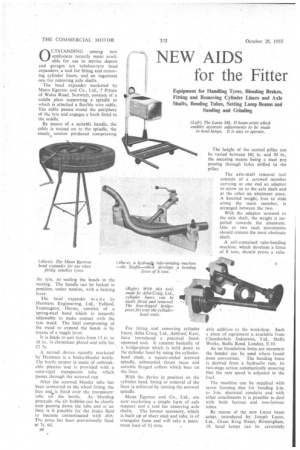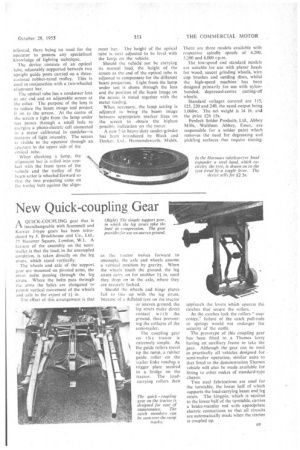NEW AIDS for the Fitter
Page 42

Page 43

If you've noticed an error in this article please click here to report it so we can fix it.
OUTSTANDING among new appliances recently made available for use in service depots and garages are tubeless-tyre bead expanders, a tool for fitting and removing cylinder liners, and an ingenious one for removing axle shafts.
The bead expander marketed by Mann Egerton and Co., Ltd., 5 Prince of Wales Road, Norwich, consists of a saddle plate supporting a spindle to which is attached a flexible wire cable. The cable passes round the periphery of the tyre and engages a hook fitted to the saddle.
By means of a suitable handle, the cable is wound on to the spindle, the steady, tension produced compressing the tyre, so sealing the beads to the seating. The handle can be locked in position, under tension, with a locking lever.
The bead expander made by Harmans Engineering, Ltd., Yelland, Fremington, Devon, consists of a spring-steel band which is instantly adjustable to make contact with the tyre tread. The final compressing of the tread to expand the beads is by means of a toggle lever. It is made to suit tyres from 13 in. to 16 in., is chromium plated and sells for £2 5s.
A second device recently marketed by Harmans is a brake-bleeder bottle. 'The bottle proper is made of unbreakable plastics and is provided with a semi-rigid transparent tube which passes through the screwed cap.
After the screwed bleeder tube has been connected to the wheel fitting, the free end.is fitted over the transparent tube on the bottle. As bleeding proceeds, the air bubbles can be clearly seen passing down the tube and at no time is it possible for the brake fluid to become contaminated with dirt. The price has been provisionally fixed at 7s. 6d.
n8
For fitting and removing cylinder liners, Ailsa Craig, Ltd„ Ashford, Kent, have introduced a practical handoperated too). It consists basically of a bridge-piece which is held down to the cylinder head by using the cylinderhead studs, a square-ended screwed spindle, substantial thrust races and suitable flanged collars which bear on the liner.
With the device in position on the cylinder head, fitting or removal of the liner is achieved by turning the screwed spindle.
Mann Egerton and Co., Ltd., are now marketing a simple fqrin of axle support and a tool for removing axle shafts. The former accessory, which is built up of sheet steel and tube, is of triangular form and will take a maximum load of '24 tons. • The height of the central pillar can be varied between 181 in. and 30 in., the securing means being a steel peg passing through holes drilled in the pillar.
The axle-shaft removal tool consists of a screwed member carrying at one end an adaptor to screw on to the axle shaft and at the other an abutment piece. A knurled weight, free to slide along the main member, is arranged between the two.
With the adaptor screwed to the axle shaft, the weight is impelled towards the abutment. One or two such movements should remove the most obstinate shaft.
A self-contained tube-bending machine, which develops a force of 8 tons, should prove a valu able addition to the workshop. Such a piece of equipment is available from Chamberlain Industries, Ltd., Staffa Works, Staffa Road, London, E.10.
As no foundation bolts are necessary the bender can be used where found most convenient. The bending force derived from a hydraulic ram, its two-stage action automatically ensuring that the ram speed is adjusted to the load.
The machine can be supplied with seven forming dies for bending fin. to 3-in, electrical conduits and with Other attachments it is possible to deal with both ferrous and non-ferrous tubes.
By means of the new Lucas beam settet, introduced by Joseph Lucas, Ltd., 6reat King Street, Birmingham, 19, head lamps can be accurately
adjusted, there being no need for the operator to possess any specialized knowledge of lighting technique.
The device consists of an optical tube, adjustably supported betwe&i two upright guide posts carried on a threecastored rubber-tyred trolley. This is used in conjunction with a two-wheeled alignment bar.
.1-he optical tube has a condenser lens at one end and an adjustable screen at the other. The purpose of the lens is to reduce the beam image and project it on to the screen. At the centre of the screen a light from the lamp under test passes through a small hole to energize a photo-electric cell connected to a meter calibrated in candelas—a measure of light intensity. The screen is visible to the operator through an aperture in the upper side of the optical tube.
When checking a lamp, the alientnent bar is rolled into contact with the front tyres of the chicle and the trolley of the beam setter is wheeled forward so that the two projecting arms on the trolley butt against the align
ment bar. The height of the optical tube is next adjusted to -be level with the lamp on the vehicle.
Should the vehicle' not be carrying its normal load, the height of the screen at the end of the optical tube is adjusted to compensate for the different beam projection. Light from the lamp under test is shone through the lens and the position of the beam image on the screen is noted together with the. meter reading.
When necessary, the lamp setting is adjusted to bring the beam image between appropriate marker lines on -the screen to obtain the highest possible indication on the meter.
A new 7-in heavy-duty sander-grinder has been introduced by Black and Decker, Lida Harmondsworth. Middx. There are three models available with respective spindle speeds of 4,200, 5.200 and 6,000 r.p.m.
The low-speed and standard models are suitable for use with planer beads for wood, saucer grinding wheels, wire cup brushes and sanding discs, whilst the high-speed machine has been designed primarily for use with nylonbonded, depressed-centre cutting-off wheels.
Standard voltages covered are 115, 125, 220 and 240, the rated output being 1,060w. The net weight is 14 lb. and the price £26 15s.
Perdeck Solder Products, Ltd., Abbey Mills, Waltham Abbey, Essex, are responsible for a solder paint which removes the need for degreasing and pickling surfaces that require tinning.




































































































